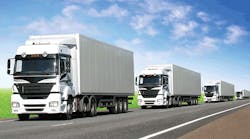The sun sets over the horizon, yet the interstate remains alit with the glow from the headlights of commercial trucks.
Deep into the witching hour, rest stops remain devoid of the telltale sign of a day on the road's end: the row of trucks lined up along the exit. The rest stops are as empty as the cabs of these vehicles.
Instead, the trucks traverse the country, wheels spinning with the hands of clocks, untethered to the human need for rest.
These driverless trucks represent what those in the industry see as the future of commercial trucking: a future guided by computers rather than by the sentient hands of a driver, a future directed by precision rather than humanity.
"Whatever happens, it's going to be big, I can tell you that," said Julia Molander, an attorney with Cozen O'Connor who serves as an adviser to insurers.
"Drones," she said, will look like "completely small potatoes compared to autonomous vehicles."
Ted Scott, director of engineering for the American Trucking Associations, sees autonomous trucks as a matter of when, not if. That's because a number of semi-autonomous features already are being incorporated into today's trucks.
The question instead, he said, is whether these autonomous vehicles will be occupied by a driver or not.
"If I have to spend $150,000 to automize a truck, why would I put a driver in it?" Scott asked. "It doesn't make sense to put a driver we're paying $50,000 to $100,000 in a truck."
Removing drivers from trucks solves a lot of the problems facing the trucking industry – the driver shortage, accidents and fuel costs. It's just a matter of public and government support of the move, which is why Scott sees fully-automated trucks ruling the roads as a "long way off."
While the industry is still in the "big picture information gathering" stage, as Molander calls it, semi-autonomous features already are making their way onto the road.
From adaptive cruise control to automatic braking to backup controls to blind spot alerts, semi-autonomous driver-assistance technologies are being manufactured into new vehicles.
"I think that probably what will ultimately happen is we'll have more and more of those semi-autonomous features that ultimately will organically grow into an autonomous vehicle," Molander said.
Dan McGehee, an occupational health professor at the University of Iowa and a driver for MyCarDoesWhat.Org – a national campaign by the National Safety Council and the University of Iowa to educate the public about autonomous vehicles – calls these features "safety technologies."
And, when you look at the data, it's hard to disagree.
Eight-seven percent of injury crashes involving large trucks (those with a gross vehicle weight rating over 10,000 pounds) in which the large truck was determined to be at fault were caused by drivers, according to the Federal Motor Carrier Safety Administration and the National Highway Traffic Safety Administration. Compare that to the 10 percent of large truck at fault injury crashes caused by the vehicle.
In taking the driver out of the picture, the reduction in the percentage of accidents caused by drivers will be "significant," Scott said.
"You're certainly going to reduce it. You may even get to the point that you invert it," Scott said.
Despite that, government agencies and the public still are wrestling with the idea of completely removing a driver from the vehicle, and thus removing a driver's ability to seize control, Molander said.
"The issue remains whether there will be a requirement to have steering wheels and brakes," Molander said. "I think that's probably a matter of human perception adjustment."
Baby Steps
In the meantime, the trucking industry also is experimenting with a concept called platooning.
Platooning involves using vehicle-to-vehicle communication to allow automobiles to safely travel closer together, cutting wind resistance, reducing accidents and increasing fuel efficiency.
In the case of the platform developed by Mountain View, Calif.-based Peloton Technology, a driver maintains control of steering while the trucks take over braking and acceleration.
"It's like having a little train go down the highway," Molander said.
Using Peloton's platooning technology, trucks save more than 7 percent in fuel while traveling at 65 mph – 10 percent for the rear truck and 4.5 percent for the lead truck, according to the North American Council on Freight Efficiency and C.R. England.
"That's sort of I think a baby step in the process of getting to a full autonomy," Scott said.
What ultimately will determine the future of autonomous vehicles in commercial trucking will be cost.
"I think that AVs are not a magic bullet. For one thing, fully automated vehicles are going to be very expensive," Molander said. "Essentially what you're looking at is giant computers on wheels."
However, those costs will be defrayed by the assumed reduction in crashes and thus liability charges, Scott said.
"The justification has got to come in the ROI," Scott said.
And that's why the move to autonomous vehicles – or even platooning – likely will be led by the larger trucking companies that can afford to invest in new technology, Scott said.
The catch is that smaller companies make up 90 percent of the industry.
"These guys are running on razor thin margins. They don't look hard at ROI," Scott said. "They are not early adopters generally of new tech and this is clearly a new tech."
Because of this, Molander predicts a consolidation of the trucking industry.
Rather than having a slew of independent contractors who are hired by logistics companies, she expects to see more trucking companies owning large fleets.
It's sort of a reverse of the trend that occurred when the trucking industry was deregulated in the 1980s, Molander said.
Scott, however, thinks there is a place for smaller companies in the autonomous trucking world.
"I think the cost will be driven down so that the smaller company can eventually get into it," Scott said, adding that there isn't yet an aftermarket for these technologies.
